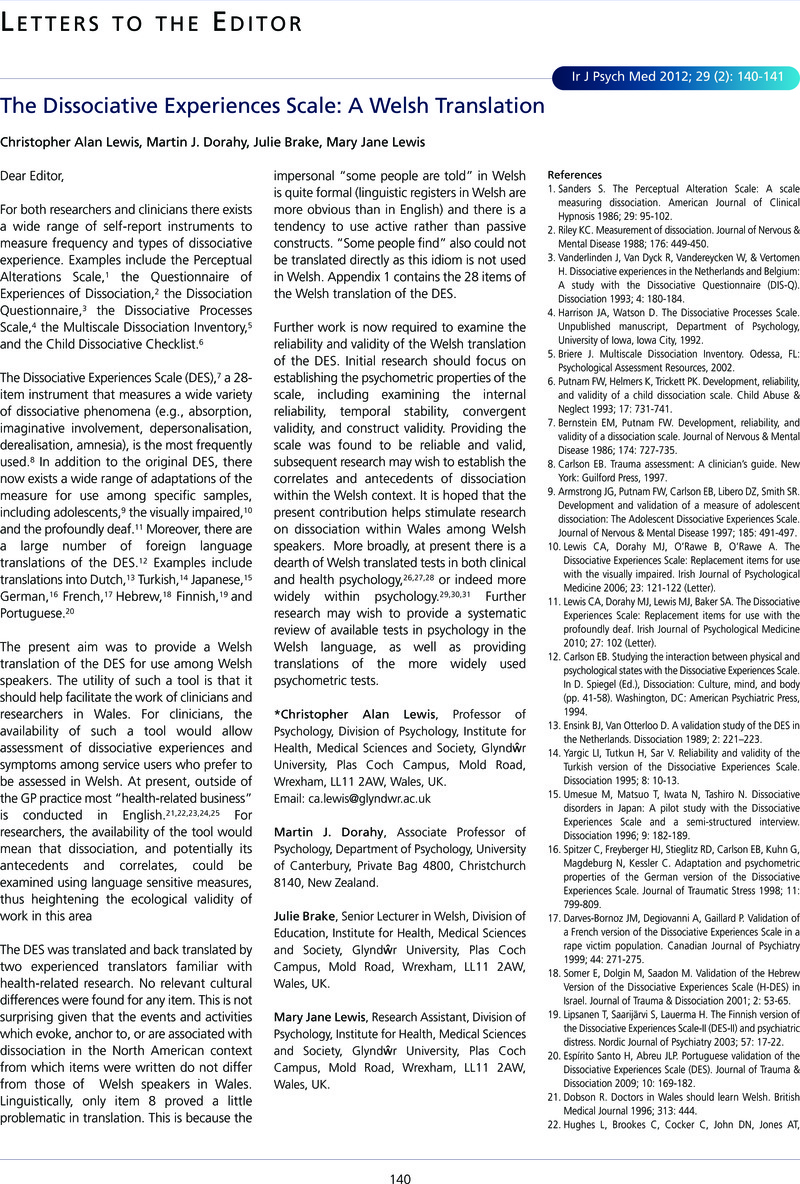No CrossRef data available.
Article contents
The Dissociative Experiences Scale: A Welsh Translation
Published online by Cambridge University Press: 13 June 2014
Abstract
An abstract is not available for this content so a preview has been provided. As you have access to this content, a full PDF is available via the ‘Save PDF’ action button.

- Type
- Letters to the Editor
- Information
- Copyright
- Copyright © Cambridge University Press 2012
References
1.Sanders, S. The Perceptual Alteration Scale: A scale measuring dissociation. American Journal of Clinical Hypnosis 1986; 29: 95–102.CrossRefGoogle Scholar
2.Riley, KC. Measurement of dissociation. Journal of Nervous & Mental Disease 1988; 176: 449–450.Google ScholarPubMed
3.Vanderlinden, J, Van Dyck, R, Vandereycken, W, & Vertomen, H. Dissociative experiences in the Netherlands and Belgium: A study with the Dissociative Questionnaire (DIS-Q). Dissociation 1993; 4: 180–184.Google Scholar
4.Harrison, JA, Watson, D. The Dissociative Processes Scale. Unpublished manuscript, Department of Psychology, University of Iowa, Iowa City, 1992.Google Scholar
5.Briere, J. Multiscale Dissociation Inventory. Odessa, FL: Psychological Assessment Resources, 2002.Google Scholar
6.Putnam, FW, Helmers, K, Trickett, PK. Development, reliability, and validity of a child dissociation scale. Child Abuse & Neglect 1993; 17: 731–741.CrossRefGoogle ScholarPubMed
7.Bernstein, EM, Putnam, FW. Development, reliability, and validity of a dissociation scale. Journal of Nervous & Mental Disease 1986; 174: 727–735.CrossRefGoogle ScholarPubMed
8.Carlson, EB. Trauma assessment: A clinician's guide. New York: Guilford Press, 1997.Google Scholar
9.Armstrong, JG, Putnam, FW, Carlson, EB, Libero, DZ, Smith, SR. Development and validation of a measure of adolescent dissociation: The Adolescent Dissociative Experiences Scale. Journal of Nervous & Mental Disease 1997; 185: 491–497.CrossRefGoogle ScholarPubMed
10.Lewis, CA, Dorahy, MJ, O'Rawe, B, O'Rawe, A. The Dissociative Experiences Scale: Replacement items for use with the visually impaired. Irish Journal of Psychological Medicine 2006; 23: 121–122 (Letter).CrossRefGoogle Scholar
11.Lewis, CA, Dorahy, MJ, Lewis, MJ, Baker, SA. The Dissociative Experiences Scale: Replacement items for use with the profoundly deaf. Irish Journal of Psychological Medicine 2010; 27: 102 (Letter).CrossRefGoogle ScholarPubMed
12.Carlson, EB. Studying the interaction between physical and psychological states with the Dissociative Experiences Scale. In Spiegel, D. (Ed.), Dissociation: Culture, mind, and body (pp. 41–58). Washington, DC: American Psychiatric Press, 1994.Google Scholar
13.Ensink, BJ, Van Otterloo, D. A validation study of the DES in the Netherlands. Dissociation 1989; 2: 221–223.Google Scholar
14.Yargic, LI, Tutkun, H, Sar, V. Reliability and validity of the Turkish version of the Dissociative Experiences Scale. Dissociation 1995; 8: 10–13.Google Scholar
15.Umesue, M, Matsuo, T, Iwata, N, Tashiro, N. Dissociative disorders in Japan: A pilot study with the Dissociative Experiences Scale and a semi-structured interview. Dissociation 1996; 9: 182–189.Google Scholar
16.Spitzer, C, Freyberger, HJ, Stieglitz, RD, Carlson, EB, Kuhn, G, Magdeburg, N, Kessler, C. Adaptation and psychometric properties of the German version of the Dissociative Experiences Scale. Journal of Traumatic Stress 1998; 11: 799–809.CrossRefGoogle Scholar
17.Darves-Bornoz, JM, Degiovanni, A, Gaillard, P. Validation of a French version of the Dissociative Experiences Scale in a rape victim population. Canadian Journal of Psychiatry 1999; 44: 271–275.CrossRefGoogle Scholar
18.Somer, E, Dolgin, M, Saadon, M. Validation of the Hebrew Version of the Dissociative Experiences Scale (H-DES) in Israel. Journal of Trauma & Dissociation 2001; 2: 53–65.CrossRefGoogle Scholar
19.Lipsanen, T, Saarijärvi, S, Lauerma, H. The Finnish version of the Dissociative Experiences Scale-II (DES-II) and psychiatric distress. Nordic Journal of Psychiatry 2003; 57: 17–22.CrossRefGoogle ScholarPubMed
20.Espírito Santo, H, Abreu, JLP. Portuguese validation of the Dissociative Experiences Scale (DES). Journal of Trauma & Dissociation 2009; 10: 169–182.CrossRefGoogle ScholarPubMed
21.Dobson, R. Doctors in Wales should learn Welsh. British Medical Journal 1996; 313: 444.CrossRefGoogle Scholar
22.Hughes, L, Brookes, C, Cocker, C, John, DN, Jones, AT, Longley, M. The role of the Welsh language in community pharmacy service provision in Wales. London: The Pharmacy Practice Research Trust, 2008.Google Scholar
23.Madoc-Jones, I. Linguistic sensitivity, indigenous peoples and the mental health system in Wales. International Journal of Mental Health Nursing 2004; 13: 216–224.CrossRefGoogle ScholarPubMed
24.Misell, A. Welsh in the Health Service: The scope, nature and adequacy of Welsh language provision in the National Health Service in Wales. Cardiff: Welsh Language Board, 2000.Google Scholar
25.Roberts, G, Irvine, F, Jones, P, Spencer, L, Baker, C, Williams, C. Report of a study of Welsh language awareness in healthcare provision in Wales. Cardiff: Welsh Assembly Government, 2005.Google Scholar
26.Francis, LJ, Thomas, EM. Welsh language adaptation of the short-form Junior Eysenck Personality Questionnaire Revised (JEPQR-S). Psychologist in Wales 2008; 21: 25–32.Google Scholar
27.Hills, PR, Francis, LJ, Thomas, E. The psychometric properties and factor structure of a Welsh translation of the School Short Form of the Coopersmith Self-Esteem Inventory. Research in Education 2007; 78: 103–109.CrossRefGoogle Scholar
28.Muntz, R, Edwards, RT, Tunnage, B, Prys, C, Roberts, GW. Development of a Welsh language version of the EQ-5D Health-Related Quality of Life Measure. Stage one: Translation. The Psychologist in Wales 2005; 18: 21–25.Google Scholar
29.Evans, TE, Francis, LJ. Measuring attitude toward Christianity through the medium of Welsh. In Francis, LJ, Kay, WKCampbell, WS (Eds.), Research in religious education (pp. 279–294). Leominster: Fowler Wright Books, 1996.Google Scholar
30.Lewis, CA, Francis, LJ. Reliability and validity of a Welsh translation of a short scale of attitude toward Christianity among 9-15 year olds. Irish Journal of Psychology 2002; 23: 101–108.Google Scholar
31.Wiliam, U, Roberts, G. The Welsh Children's Intelligence Scale. Windsor: NFER, 1972.Google Scholar


